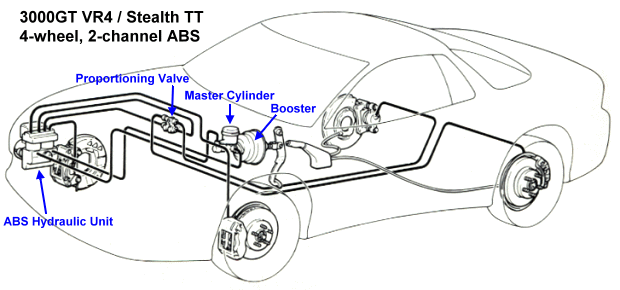
|
Click here for a printable version of this web page. The Adobe Acrobat Reader is required to view and print the printable version. misc/stealth316-brakeupgrade.pdf (731 KB) |
||||||||||||||
| 3S Stock Braking Performance | |||||
|---|---|---|---|---|---|
| Magazine | Issue | Car | 60-0 mph | 80-0 mph | 100-0 mph |
| Sports Car Int'l | 9/90 | '91 TT | 120 ft | 214 ft | |
| Road & Track | 9/90 | '91 VR4 | 135 ft | 237 ft | |
| Motor Trend | 3/91 | '91 VR4 | 117 ft | ||
| Sports Car Int'l | 12/93 | '94 VR4 | 123 ft | 223 ft | |
| Sports Car Int'l | 8/95 | '95 VR4 | 123 ft | ||
| Road & Track | 8/96 | '97 VR4 | 347 ft in 4.5 s | ||
| Sports Car Int'l | 10/96 | '95 Spyder | 134 ft | ||
| Motor Trend | 5/97 | '97 VR4 | 116 ft | ||
| Road & Track | 1999 spec. | '99 VR4 | 122 ft | 218 ft | |
| Stock Dimensions | ||||||
|---|---|---|---|---|---|---|
| AWD year | Front | Rear | ||||
| Rotor O.D. mm (in) |
Rotor Thickness mm (in) |
Cylinder ID mm |
Rotor O.D. mm (in) |
Rotor Thickness mm (in) |
Cylinder ID mm |
|
| 1991-1993 | 295 (11.62) | 30 (1.18) | 40.4 x 2 + 42.8 x 2 |
284 (11.19) | 20 (0.79) | 38.1 x 1 |
| 1994+ | 314 (12.36) | 30 (1.18) | 40.4 x 2 + 42.8 x 2 |
295 (11.62) | 20 (0.79) | 38.1 x 2 |

| WARNING. Brake fluid is poison. Keep it away from skin and eyes. Do not allow brake fluid to contact painted surfaces. |
| Standard Brake Fluids | ||||
|---|---|---|---|---|
| DOT 3 | DOT 4 | DOT 5 | DOT 5.1 | |
| Dry BP ºF (ºC) | 401 (205) | 446 (230) | 500 (260) | 500 (260) |
| Wet BP ºF (ºC) | 284 (140) | 311 (155) | 356 (180) | 356 (180) |
| Kin. Viscosity mm2/second |
1500 max @ -40ºF 1.5 min @ 212ºF |
1800 max @ -40ºF 1.5 min @ 212ºF |
900 max @ -40ºF 1.5 min @ 212ºF |
900 max @ -40ºF 1.5 min @ 212ºF |
| Advantages | - Inexpensive - Readily available |
- Available at auto parts stores - Less hydroscopic than DOT3 |
- Does not attack paint - Does not absorb water |
- Superior performance |
| Disadvantages | - Attacks paint! - Most hydroscopic |
- Attacks paint! - More expensive than DOT3 |
- DOES NOT mix with DOT3, DOT4, DOT5.1 - Water may "puddle" in the system - Careful bleeding required - Slightly compressible near its boiling pt. - Very expensive, hard to find |
- Attacks paint! - Expensive, hard to find |
| High-Performance Brake Fluids | ||||||||||||||
|---|---|---|---|---|---|---|---|---|---|---|---|---|---|---|
| Motul Ultra 5.1 | AP Ultra 5.1 | Ate Typ 200 | Ford HD | AP 550 | Brake Man | Earl's Hypertemp 421 | NEO | Motul Racing 600 | AP Super 600 | Castrol SRF | Motul RBF 600 | NEO Super DOT 610 | GS610 | |
| Dry BP ºF (ºC) |
509 (265) |
518 (270) |
536 (280) |
550 (288) |
563 (295) |
577 (303) |
585 (307) |
585 (307) |
585 (307) |
590 (310) |
590 (310) |
593 (311) |
610 (321) |
610 (321) |
| Wet BP ºF (ºC) |
365 (185) |
375 (191) |
392 (200) |
290 (143) |
293 (145) |
300 (149) |
421 (216) |
421 (216) |
421 (216) |
410 (210) |
518 (270) |
420 (216) |
421 (216) |
421 (216) |
| Price per liter |
$12-14 | ~$14-20 | $10-15 | ~$6 | ~$28 | $25 | ~$30 | $34 | ~$18-21 | ~$36-40 | $65-75 | ~$30 | ~$34 | ~84 |
|
|
||||||||||||||||||||
| Porterfield Brake Products To order contact: orders@speedtoys.com |
||||||||
|---|---|---|---|---|---|---|---|---|
| Product | Part number | Price ($US) | ||||||
| Mitsubishi 3000GT SL (all years) | ||||||||
| Front Rotors | JBR 583 | $79.95 | ||||||
| Rear Rotors | JBR 584 | $80.00 | ||||||
| Front Pads | R4S AP 530 | $83.00 | ||||||
| Rear Pads | R4S AP 383 | $63.00 | ||||||
| 1st Gen Mitsubishi 3000GT VR4 (4/90 to 5/93 production) | ||||||||
| Front Rotors | JBR 582 | $82.00 | ||||||
| Rear Rotors | JBR 585 | $90.00 | ||||||
| Front Pads | R4S AP 531 | $69.00 | ||||||
| Rear Pads | R4S AP 532 | $56.00 | ||||||
| 2nd Gen Mitsubishi 3000GT VR4 (6/93+ production) | ||||||||
| Front Rotors | JBR 785 | $104.50 | ||||||
| Rear Rotors | JBR 786 | $99.00 | ||||||
| Front Pads | R4S AP 531 | $69.00 | ||||||
| Front Pads | R4 AP 531 or R4E AP 531 | $116.00 | ||||||
| Rear Pads | R4S AP 631 | $76.00 | ||||||
| Rear Pads | R4 AP 631 or R4E AP 631 | $95.00 | ||||||
| Porsche Big Red Calipers | ||||||||
| Front Pads | R4S AP 594 | $128.00 | ||||||
| Front Pads | R4 AP 594 or R4E AP 594 | $137.00 | ||||||
| Rotor prices are for each rotor. Check for current prices. Rotors are made by Brembo, Bradi, ATE, or American made. Add $45 per rotor for each of these processes: slotting, drilling, cryo-treatment |
||||||||
|
Pad prices are for both left and right wheels. Check for current prices. All pads are a Carbon Kevlar blend made by AP Racing. R-4: Race Versatile and a superior performer. R-4 S: Street High-performance & Limited Competition The high performance street pad of choice. No dust or squeal. Very high friction level even at cold temperatures. R-4 E: Endurance Racing Pads with Longer Life This is an endurance pad, especially formulated for long races. It runs cool and wears longer than the R-4. Great for extended time events. |
||||||||
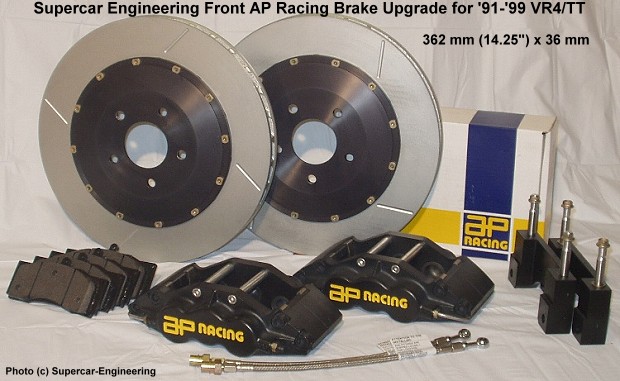
| Front Caliper Information | ||||||||
|---|---|---|---|---|---|---|---|---|
| Caliper | Piston 1 (mm) |
Piston 2 (mm) |
Piston 3 (mm) |
Total Piston Area (mm2) |
Total Piston Area (in2) |
Difference from stock |
Brake Pad Area (in2) |
Weight (lb) |
| Brembo F50 | 40.0 | 44.0 | -- | 2777 | 4.30 | 2.06% | 9.6 | 7.01 |
| StopTech ST40 "F50" | 40.0 | 44.0 | -- | 2777 | 4.30 | 2.06% | 9.6 | 7.01 |
| Stock VR4/TT | 40.4 | 42.8 | -- | 2721 | 4.22 | 0% | 8.0 | 8.0 |
| Alcon | 38.1 | 44.5 | -- | 2695 | 4.18 | -0.96% | ? | ? |
| StopTech ST40 "F40" | 38.0 | 44.0 | -- | 2655 | 4.11 | -2.43% | 9.6 | 7.01 |
| Brembo F40 | 38.0 | 44.0 | -- | 2655 | 4.11 | -2.43% | 9.6 | 7.01 |
| Porsche Big Black | 38.0 | 44.0 | -- | 2655 | 4.11 | -2.43% | 9.6 | ? |
| Porsche Big Red | 36.0 | 44.0 | -- | 2538 | 3.93 | -6.73% | 9.6 | 8.1 |
| MOV'IT | 36.0 | 44.0 | -- | 2538 | 3.93 | -6.73% | ?? | ?? |
| StopTech ST40 (332mm rotor) | 38.0 | 42.0 | -- | 2520 | 3.91 | -7.39% | 9.6 | 7.01 |
| AP Racing | 27.0 | 32.0 | 38.0 | 2511 | 3.89 | -7.72% | 11.8 | 6.6 |
| StopTech ST40 (355mm rotor) | 36.0 | 40.0 | -- | 2274 | 3.53 | -16.43% | 9.6 | 7.01 |
| StopTech ST40 (380mm rotor) | 34.0 | 40.0 | -- | 2165 | 3.36 | -20.43% | 9.6 | 7.01 |
| Front Rotor Information | ||
|---|---|---|
| Rotor | Diameter mm (in) |
Thickness mm (in) |
| 1991-1993 VR4/TT 1994 - end VR4/TT |
295 (11.62) 314 (12.36) |
30 (1.18) 30 (1.18) |
| StopTech | 380 (14.96) 355 (13.98) 332 (13.07) |
32 (1.26) 32 (1.26) 32 (1.26) |
| AP Racing | 362 (14.25) 355 (13.98) 343 (13.50) |
36 (1.42) 35.5 (1.40) 35.5 (1.40) |
| Brembo | 355 (13.98) 343 (13.50) |
32 (1.26) 32 (1.26) |
| Alcon | 332 (13.07) | ? (?) |
| Porsche GT2 max w/ "Big Red" max w/ "Big Black" |
322 (12.68) 332 (13.07) 322 (12.68) |
32 (1.26) 32 (1.26) 32 (1.26) |
| MOV'IT | 322 (12.68) | 32 (1.26) |
| StopTech and Supercar Engineering Recommendations | |||||
|---|---|---|---|---|---|
| Rotor Diam. mm (in) |
Diff. from stock 295mm |
Diff. from stock 314mm |
ST40 Pistons | Piston area mm |
Diff. from stock |
| 380 (14.96) | 28.81% | 21.02% | 2x34/40mm | 2165 | -20.43% |
| 355 (13.98) | 20.34% | 13.06% | 2x36/40mm | 2274 | -16.43% |
| 332 (13.07) | 12.54% | 5.73% | 2x38/42mm | 2520 | -7.39% |
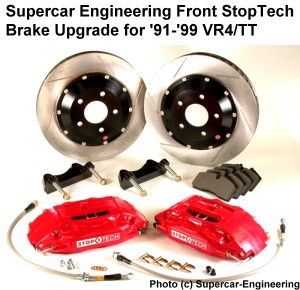
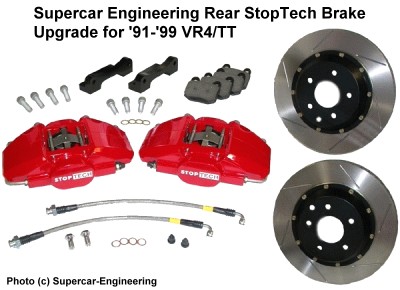
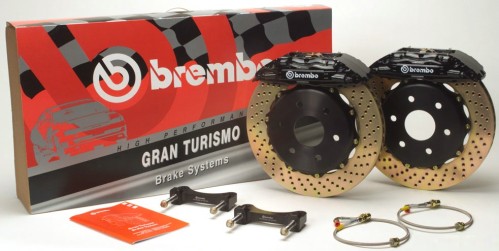
|
---------- Original Message ---------- From: "Ken Middaugh" To: [edited] Cc: stealth_d@starnet.net; Team3S@stealth-3000gt.st Sent: Thursday, October 12, 2000 12:40 PM Subject: Team3S: Brake summary (long), was: Brake Kit Discount Available As you may recall, some of us track and "deceleration" enthusiasts banded together in search of better, reasonably priced brakes for our cars. There are already lots of kits available for our cars, but most are expensive. We wanted something that was economical, yet was a big improvement over stock brakes. Our original goal was to fund research and development of a 2 piece rotor for Brad Bedell's Porsche "Big Red" upgrade kit. With a 2-piece rotor, Brad's kit would be very similar to Mov'it's $2800 kit but we were hoping that Brad's kit with a 2-piece rotor would be about $2100. A lot of investigation was done and here is a summary. We ended up not spending any money on R&D since our investigation uncovered existing economical solutions. It turns out that there would be little if any cost savings if Brad were to fabricate his own hats for 2 piece rotors versus just buying them from a reputable and experienced manufacturer. Front Kits $1450 Brad's Big Red kit, http://home.austin.rr.com/overboost/. It currently sells without rotors but includes Porsche 993 calipers, caliper mounting brackets, Goodridge stainless steel brake lines for 4 wheels, a set of pads, and fluid. This is the entry point to serious brake upgrades and folks have reported dramatic results. With a set of $250 Porterfield rotors you can seriously upgrade stock performance for about $1700. ~$1900 KVR "Lobster" kit (his name for the Big Reds) with 2 piece Porsche rotors. Terry Gosse of KVR, http://www.kvrperformance.com, has been doing custom brake kits for many years and has a lot of knowledge and experience. Basically, he can do anything for any budget. This price was approximate, and includes Porsche 993 calipers, mounting brackets, 2 piece rotors using Porsche GT2 322x32mm disks and custom 6061 T6 aluminum hats, stainless steel lines for the front, AP racing fluid. I don't know if this price would include SS lines for the rear, or include pads. However, this is basically the same thing as the Mov'it kit for a lot less money. Porsche makes awesome disks. They are directionally veined, the holes are cast and then drilled to final diameter. If desired, he could substitute other, larger disks for about the same price. KVR also has directionally veined disks that you can get solid, cross drilled, or slotted. The Porsche and KVR disks have "reasonable" replacement costs, less than $200 each. The hats should last 5 racing seasons or a lifetime on the street. ~$2100 KVR "Big Black" kit with Porsche 928 S4 calipers with 2 piece rotors. This kit is the same as the above Lobster kit except for the calipers. Terry Gosse of KVR says these calipers will be a better match for our car since the 928 is a similar heavy weight, front engine car like ours (VR4). The Big Red calipers are for lighter, rear engine cars. The Big Black calipers have 2x38x44mm pistons while the Big Red has 2x36x44mm pistons. This extra 2mm makes a big difference over 4 total pistons. Also the Big Black calipers are bolted together more near the centerline and will deflect less than the Big Reds. The Big Blacks use shorter 50mm pads, which deflect less than the Big Reds 60mm pads. The Big Blacks can accommodate 332mm rotors while the Big Reds max size is 322mm. Finally, there are more pad choices for the Big Blacks versus the Big Reds. This is IMHO the best deal of the survey. ~$2200 Stillen Brembo kit, http://www.stillen.com/brakes/systems/systems.html. This was the price a few years ago. Some folks have this and are very happy, but others have reported that their cross drilled disks crack and warp. The replacement disks are also costly. Supposedly, the Porsche treatment of Brembo calipers in the above kits is better than the stock Brembo caliper in this kit. The calipers do compare to the 928 though since the pistons are also 2x38x44mm. ~$2100 - $2800 Mov'it Big Red kit, http://www.ultimategarage.com. The Ultimate Garage's web site say they utilize the Porsche 996 monobloc calipers (instead of the 993) and the GT2 2 piece rotors. These 996 calipers would make it better than the above Lobster kit. Supposedly, our European friends can get these directly from Mov'it for about $2100 although Ultimate Garage's price is $2800. I think Roger Gerl was investigating becoming a Swiss distributor. $2500 - $3000 KVR AP Racing 6 piston caliper and 2 piece rotors. Terry said he could sell this kit for $2500 for a group purchase of 5 or more. $3000 is the normal price. I'm not sure if this is the identical kit to the one on Stillens web page. This is the entry to the "very serious" upgrades and is really a step above the previous kits. It can accommodate 355x35.5mm rotors! $3000+ There are other kits available but not investigated because of their prices. Mov'it's Terminator kits (14.9" disks!!), Baer, and Wilwood, come to mind. Probably the awesome looking NewTech fits this category too. Rear Kits ~$1800 - $2600 Mov'it has a kit for the rear brakes too. It uses Boxter S components including a 299x24mm rotor. It should cost about $1800 in Europe but $2600 in the states. Summary All of these kits including the Mov'it kits should fit '91+ 3000GTs and Stealths, as long as you have the wheel clearance. To improve clearance and increase front track width (reduces under steer), you could utilize a thicker facing on the hat with longer wheel studs. Since Mov'it is now using 996 calipers, it would be worthwhile to compare them with the 928 S4 caliper. Regardless, Terry Gosse of KVR should be able to build custom front kits with any caliper and any disk and still have unbeatable prices. Happy braking, Ken ---------- End Original Message ---------- |
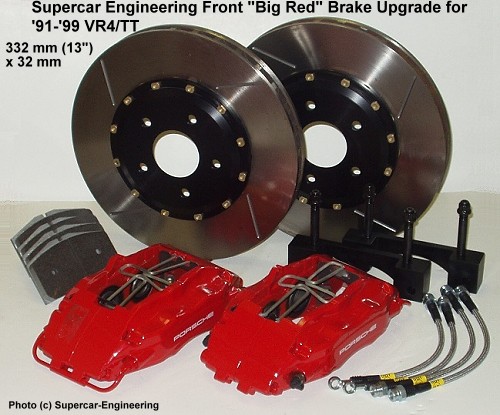
| Available Front Big Brake Kits | |||||
|---|---|---|---|---|---|
| Manufacturer | Rotor sizes (mm) | Caliper pistons (mm) | |||
| Alcon | 332x?? | 2x38.1/44.5 | |||
| AP Racing | 343x35.5, 355x35.5, 362x36 | 2x27/32/38 | |||
| Brembo | 343x32, 355x32 | 2x38/44, 2x40/44 | |||
| MOV'IT | 322x32 | 2x36/44 | |||
| Porsche | 322x32, 332x32 | 2x36/44, 2x38/44 | |||
| StopTech | 332x32, 355x32, 380x32 (28 or 35 widths avail.) | combinations of 34, 36, 38, 40, 42, 44 | |||
| Available Rear Big Brake Kits | |||||
|---|---|---|---|---|---|
| Manufacturer | Rotor sizes (mm) | Caliper pistons (mm) | |||
| MOV'IT | 299x24 | 2x?? | |||
| StopTech | 328x28 | 2x36 (other sizes available) | |||
| Back | Home | Forward |